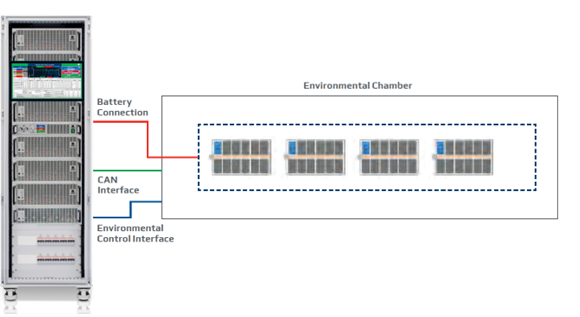Redefine Battery Testing with the BTS 10300 Series
The EA-BTS 10300 Series Battery Cycler & Test System is engineered to meet the rigorous demands of modern battery and energy storage testing. Featuring voltage ranges up to 1500 VDC (optional 2000 VDC), current capacities up to 30,720 A, and power scalability up to 3.84 MW, it delivers unparalleled performance for applications ranging from EV battery packs to industrial grid storage.
This advanced system integrates 96.5% energy regeneration efficiency, true autoranging for continuous cycling, and modular rack configurations that adapt to your evolving testing requirements. Its widget-based software interface eliminates the need for coding, allowing users to program tests and analyze data effortlessly. With robust safety features, including temperature monitoring and reverse polarity protection, the BTS 10300 Series ensures precise and reliable results.
Whether you are developing next-generation batteries, optimizing energy systems, or conducting research and development, the EA-BTS 10300 Series provides the tools you need to innovate with confidence.
A typical, non EA multi-rack battery pack testing system

Compared wtih the EA-BTS 10300 System that integrates all of the testing and communications into a single rack
Expandable power capacity from 30-300kW to a maximum of 3.84MW
The EA-BTS 10300 system sets itself apart from conventional test systems with its TRUE autoranging feature. This unique capability allows the programmable power source to deliver the necessary power across a broad spectrum of voltage conditions, offering unparalleled flexibility and efficiency in battery testing.

Specifications
Power Configurations
30 kW, 60 kW, 90 kW, 100 kW, 120 kW, 180 kW, 200 kW, 240 kW, 300 kW
Tests
Can be user-defined such as capacity, four seasons, pulse, and imported drive cycling.
Battery Cycling
- Voltage range: 0–1500 VDC (0–2000 VDC optional)
- Current range: ±30,720 Amps (single cabinet ±2,400 Amps)
- Power range: 0–3.84 MW (single rack up to 300 kW)
Drive Cycle Simulations
FUDS, SFUDS, GSFUDS, DST, and ECE-ISL
Battery Monitoring
- Parameters: voltage, current, power, step, total AH/WH
- Sampling rate: 1.6 kHz
- BMS signals
- Input from battery for limitations from BMS to cycler
Interface to Battery Management System
CAN bus
Chiller and Environmental Chamber Control
Interface to temperature controllers
Configurable User Variables and Alarms/Warnings
Pick and choose logs, what rate to record, and which signals
Supports multiple log foles at once
Safety Features
- Battery pack temperature monitoring:
- Sensor: Thermocouple Type K standard, system can be built with other types
- Temperature range: Depending on thermocouple chosen
- Accuracy: Depending on thermocouple chosen
- Voltage matching accuracy: ≤1% battery voltage
- Polarity reversal check:
- E-Stop
- Configurable emergency shutdown sequence
Software
- Export data format: CSV and TDMS (NI structured binary format; can be read in MATLAB), HDF5
- Widget-based display control
System Input Power Requirements
380 V / 400 V / 480 V ±10%, 3-phase AC (Wide range AC input)
Test System Cooling Requirements
Forced air (Water cooling optional)
Power Delivery and Absorption Performance
96.5% regeneration to the grid
Standard I/O
- 4 Digital outs
- 5 Digital ins
- 4 Analog ins
- 3 Thermocouple inputs (Type K) can be ordered with other types
Optional Features
- Multichannel control
- Chiller control
- Vehicle charging protocol and control
- Custom solutions also available – inquire with your regional sales representative
Resources
Interfaces and Software
EA-BTS battery test software controls all battery cycling and battery test operations and enables:
- Defining the tests to be performed
- Entering parameters for the tests
- Defining the order in which tests are performed
- Defining the data to be monitored and exported
- Defining the layout of the display screen
The Software uses a Widget-based approach to allow a user-configurable display. Set up and test execution is simple and fast and allows complete tests on a battery or another power source, such as a fuel cell.



